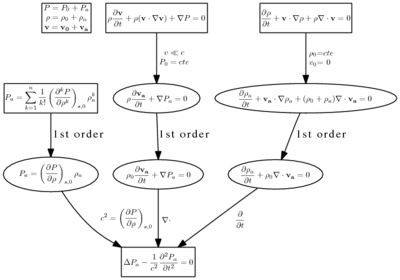Acoustic wave equation
In physics, the acoustic wave equation governs the propagation of acoustic waves through a material medium. The form of the equation is a second order partial differential equation. The equation describes the evolution of acoustic pressure or particle velocity u as a function of position x and time . A simplified form of the equation describes acoustic waves in only one spatial dimension, while a more general form describes waves in three dimensions.
For lossy media, more intricate models need to be applied in order to take into account frequency-dependent attenuation and phase speed. Such models include acoustic wave equations that incorporate fractional derivative terms, see also the acoustic attenuation article or the survey paper.[1]
In one dimension
Equation
The wave equation describing sound in one dimension (position ) is
where is the acoustic pressure (the local deviation from the ambient pressure), and where is the speed of sound.[2]
Solution
Provided that the speed is a constant, not dependent on frequency (the dispersionless case), then the most general solution is
where and are any two twice-differentiable functions. This may be pictured as the superposition of two waveforms of arbitrary profile, one () travelling up the x-axis and the other () down the x-axis at the speed . The particular case of a sinusoidal wave travelling in one direction is obtained by choosing either or to be a sinusoid, and the other to be zero, giving
- .
where is the angular frequency of the wave and is its wave number.
Derivation

The derivation of the wave equation involves three steps: derivation of the equation of state, the linearized one-dimensional continuity equation, and the linearized one-dimensional force equation.
The equation of state (ideal gas law)
In an adiabatic process, pressure P as a function of density can be linearized to
where C is some constant. Breaking the pressure and density into their mean and total components and noting that :
- .
The adiabatic bulk modulus for a fluid is defined as
which gives the result
- .
Condensation, s, is defined as the change in density for a given ambient fluid density.
The linearized equation of state becomes
- where p is the acoustic pressure ().
The continuity equation (conservation of mass) in one dimension is
- .
Where u is the flow velocity of the fluid. Again the equation must be linearized and the variables split into mean and variable components.
Rearranging and noting that ambient density changes with neither time nor position and that the condensation multiplied by the velocity is a very small number:
Euler's Force equation (conservation of momentum) is the last needed component. In one dimension the equation is:
- ,
where represents the convective, substantial or material derivative, which is the derivative at a point moving with medium rather than at a fixed point.
Linearizing the variables:
- .
Rearranging and neglecting small terms, the resultant equation becomes the linearized one-dimensional Euler Equation:
- .
Taking the time derivative of the continuity equation and the spatial derivative of the force equation results in:
- .
Multiplying the first by , subtracting the two, and substituting the linearized equation of state,
- .
The final result is
where is the speed of propagation.
In three dimensions
Equation
Feynman[3] provides a derivation of the wave equation for sound in three dimensions as
where is the Laplace operator, is the acoustic pressure (the local deviation from the ambient pressure), and where is the speed of sound.
A similar looking wave equation but for the vector field particle velocity is given by
- .
In some situations, it is more convenient to solve the wave equation for an abstract scalar field velocity potential which has the form
and then derive the physical quantities particle velocity and acoustic pressure by the equations (or definition, in the case of particle velocity):
- ,
- .
Solution
The following solutions are obtained by separation of variables in different coordinate systems. They are phasor solutions, that is they have an implicit time-dependence factor of where is the angular frequency. The explicit time dependence is given by
Here is the wave number.
Cartesian coordinates
- .
Cylindrical coordinates
- .
where the asymptotic approximations to the Hankel functions, when , are
- .
Spherical coordinates
- .
Depending on the chosen Fourier convention, one of these represents an outward travelling wave and the other a nonphysical inward travelling wave. The inward travelling solution wave is only nonphysical because of the singularity that occurs at r=0; inward travelling waves do exist.
See also
- Acoustics
- Acoustic attenuation
- Acoustic theory
- Wave Equation
- Differential Equations
- Thermodynamics
- Fluid Dynamics
- Pressure
- Ideal Gas Law
References
- S. P. Näsholm and S. Holm, "On a Fractional Zener Elastic Wave Equation," Fract. Calc. Appl. Anal. Vol. 16, No 1 (2013), pp. 26-50, DOI: 10.2478/s13540-013--0003-1 Link to e-print
- Richard Feynman, Lectures in Physics, Volume 1, Chapter 47: Sound. The wave equation, Caltech 1963, 2006, 2013
- Richard Feynman, Lectures in Physics, Volume 1, 1969, Addison Publishing Company, Addison